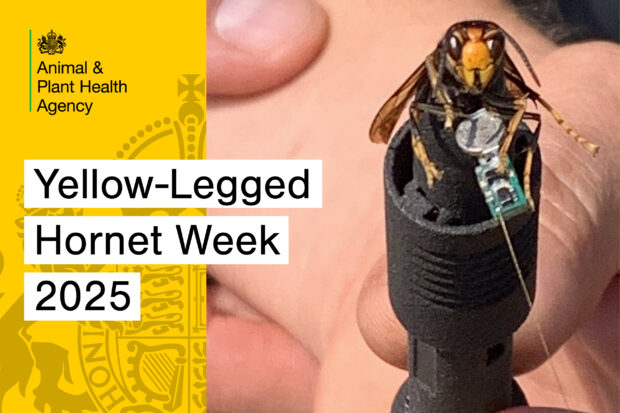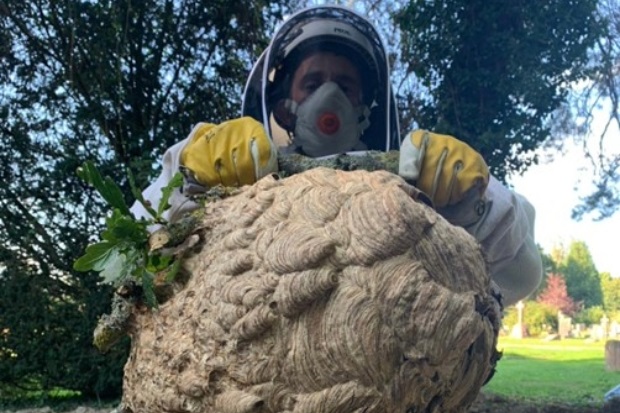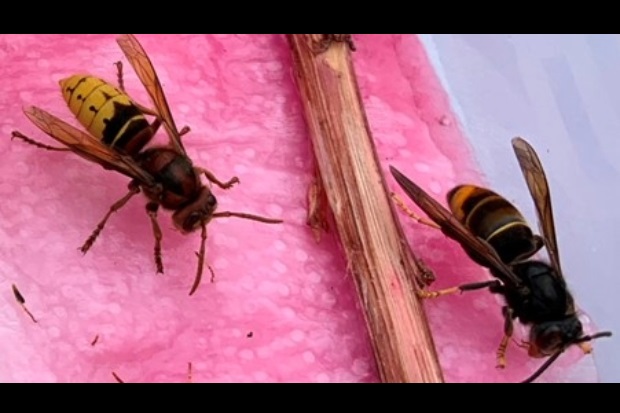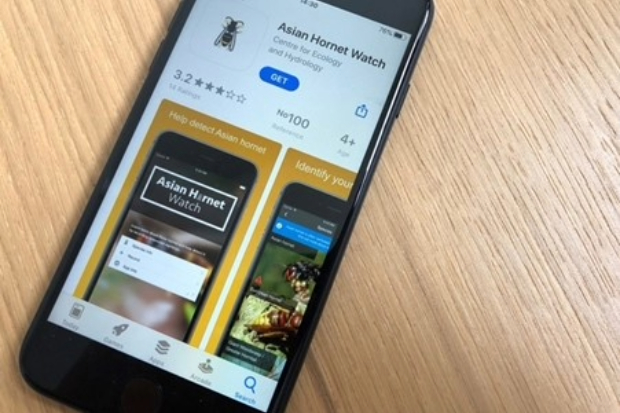
In the quiet hum of summer gardens, a new buzz is making headlines, and it is not just the bees. Across England, Animal and Plant Health Agency’s (APHA) National Bee Unit (NBU) is leading a high-tech charge against one of the most destructive invasive species threatening our pollinators: the yellow-legged hornet (YLH), also known as the Asian hornet.
Their secret weapon? Micro-transmitters which are tiny devices turning hornets into unwitting allies in the hunt for their own nests.
The hornet threat is growing
First detected in the UK in 2016, the yellow-legged hornet (Vespa velutina) has spread rapidly across Europe since its arrival in France in 2004. With no natural predators and a voracious appetite, a single nest can consume over 11 kilograms of insects in one season including bees, wasps, spiders, and other pollinators. Honeybees are a particular favourite prey for YLH and make up around 40% of their diet.
This predation poses a serious threat to biodiversity and agriculture. For fruit growers and beekeepers, the hornet’s presence can be catastrophic, disrupting pollination and decimating colonies.
From 2016 to 2022, the NBU dealt with just one or two sightings and nest finds per year. But in 2023, that number skyrocketed to 72 nests found and destroyed. During 2024, nearly 30,000 reports were made via the Asian Hornet Watch app, with approximately 70 being credible and 24 nests found. At the time of writing, 72 nests have been found this year, and the season is not over yet.
Tracking the enemy
The traditional method for locating hornet nests is often a labour-intensive process. And despite continued refinement following the increase in reports over the last three years, teams of inspectors can spend days tracking feeding hornets from bait stations, marking them with coloured pens, timing their return visits, and estimating flight paths often in challenging locations, in order to finally locate the nest.

Enter the micro-transmitter: a game-changer in pest control
This summer, the NBU trialled a dramatic new approach: fitting live hornets with micro-transmitters to trace their flight paths back to their nests. Developed by Robor Nature in the Netherlands, these marvels of modern engineering weigh less than 160mg and feature shortened antennas to minimise discomfort for the hornet. They are rechargeable, adjustable, and reusable, making them a sustainable and cost-effective solution.
Dan Etheridge, Regional Bee Inspector, shared with BBC News South East:
“We have already used six tags (transmitters) and have found six nests (all in less than an hour of attachment), so it is going to speed things up dramatically for what we do in the field.”
That is a staggering improvement in efficiency.
Practical innovation
One of the most revolutionary aspects of this system is its simplicity. The transmitter can be attached in just five seconds without anesthetising the hornet. This reduces stress for the insect and allows for immediate release, streamlining the process and making it accessible to trained personnel.
Here is how it works:
- Inspectors attend credible sightings
- Hornets are encouraged to feed at bait stations
- A confidently feeding hornet is marked with a coloured pen
- Once it returns reliably, it is captured again and fitted with a transmitter
- Released, the hornet becomes a flying beacon
Using handheld directional receivers, smartphone apps, or even drones, inspectors can track the hornet’s movements with pinpoint accuracy. Signal strength is displayed via LED indicators and audio pitch, guiding inspectors directly to the nest.
Triangulation using three receivers allows teams to quickly home in on the nest site. Once located, the hornet often returns to the bait station, where it can be recaptured and the transmitter reused.
Mobilising the public: your role in the fight
Public awareness is a crucial component of this battle. Misidentification remains a major issue, which is why the name change from “Asian hornet” to “yellow-legged hornet” is so important. Their yellow legs, dark body, and single broad band across the lower abdomen are striking features that help distinguish them from native species.

The Asian Hornet Watch App is a vital tool in this effort. In 2024, it helped generate nearly 30,000 reports. We urge everyone to download the app and stay informed. Your reports could be the key to locating a nest and preventing further spread.
Scaling up: what is next?
Having proved successful in the field, four sets of transmitter equipment were ordered and delivered in August 2025. Training of inspectors is now underway, and deployment is imminent.
This equipment could prove to be a game-changer in maintaining the eradication of YLH. With each tagged hornet, we gain a new opportunity to strike at the heart of the problem, one nest at a time.
So next time you hear a buzz in the garden, remember: it might just be the sound of science in action.
What you can do today

- Download the Asian Hornet Watch App
- Report any sightings promptly (you can also do this by online form and email)
- Share the app with friends, family, and colleagues
- Stay informed via the NBU’s rolling update page for 2025
- Use the identification sheet to help with accurate identification
Together, we can protect our pollinators and preserve the delicate balance of our ecosystems.
Subscribe to our blog
We share fascinating stories all year round: from behind-the-scenes glimpses into our cutting-edge scientific work to updates on the latest events and breakthroughs we are part of.
Want to stay in the loop? Subscribing to our blog takes just seconds, and you will get instant email alerts whenever a new post goes live. Do not miss out!

Recent Comments